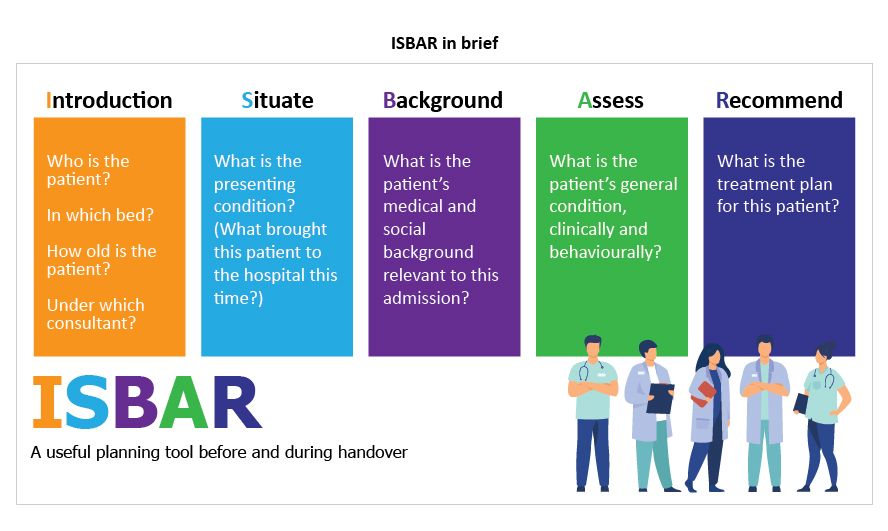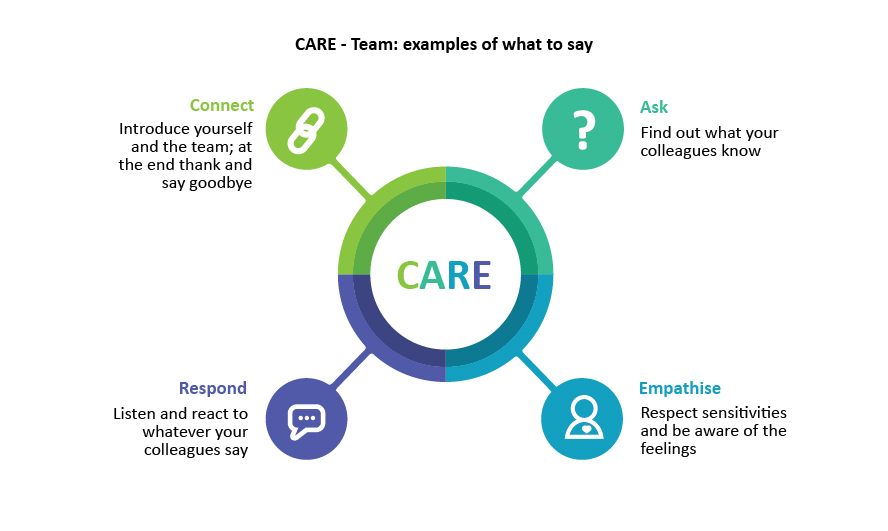Main navigation

The communication scheme derived from research and adopted by clinical practitioners in hospitals, hospice or homes elevated the quality of care rendered to patients and made the change of shifts of care givers “seamless.”
If you’ve ever had to stay in a hospital because of accident or illness, you probably think that the medical procedures, such as an operation or tests, as the most critical events. These are indeed pivotal to patient care, but so is an event that happens several times a day: the transfer of patient information between clinical staff. As patients, we are probably not even aware of this “clinical nursing handover”.
The transfer of responsibility and accountability between nurses for continuity of patient care most often happens between outgoing and incoming nursing shifts. It is an crucial act of communication that has effects on both patient safety and risk management. Research reports that many handovers around the world lack spoken interaction and are incomplete, making them a major contributor to patient harm. It is this area of interest that Dr Jack Pun, Assistant Professor at Department of English, City University, and his collaborators from Australia and Hong Kong decided to take on. He works within the field of Applied Linguistics, with his research focusing on the role of language in health communication. Using video recordings, actual observations and analysing nurses’ authentic spoken interactions at handovers, his team developed an “evidence-based practice” training module to support 50 frontline nurses for professional development and enhance the quality of nursing handovers. The project has earned him the CityU CLASS College Excellence in Knowledge Transfer Award 2020.
What is clinical handover?

Clinical handover is the practice by which information about and responsibility for a patient are transferred from one nurse or nursing team to another. It most usually occurs in hospitals between shifts, given that nursing takes place 24/7. However, handovers are also carried out between different wards, clinical sites, hospital departments or when patients move from the hospital into the community or to nursing homes.
Consider the negative results of ineffective communication: inappropriate transfer of patient’s latest information, unsuitable treatment plans, incorrect medication dosage, omission of care, or, in the worst-case scenario, patient death. Face-to-face handover communication is essential so outgoing nurses can read back to the incoming shift treatment plans, completed procedures and tests, and any important orders from the doctors for the patients under their next shift of care. Furthermore, the incoming nurses can ask questions in order to clarify various aspects and obtain a fuller picture of the patients’ conditions.
Migrating from passive to active
“At CityU we implemented a handover protocol, validated in a Hong Kong hospital context, that helps the local nurses migrate from a passive to an active role, in recognition of their shared responsibility for patient care,” says Dr Pun. An evidence-based practice training model was developed in a Hong Kong hospital using video recordings, observations and analysis of nurses’ spoken interactions during handovers. From this, the team developed a training module aimed at enhancing the quality of the patient care and handover process.
The project was carried out in collaboration with Hong Kong Sanatorium & Hospital, the Hospital Authority, School of Nursing at Hong Kong Polytechnic University, and Institute of Communication in Health Care at Australian National University.
Two key handover communication protocols were established for nurses in a Hong Kong context to follow at clinical handover: ISBAR and CARE.
ISBAR is a logical sequence for transferring patient information:

- Identify - patient and responsible doctor
- Situation - patient’s condition
- Background - patient’s medical and social background
- Assessment & Action - patient’s clinical condition and what has been carried out on the earlier shift)
- Recommendation & Read back - explain what needs to be done and hand over the accountability to incoming team
CARE improves the quality of verbal interactions between outgoing and incoming nurses, by engaging them in active conversation with elements of

- Connect - greet the new team and prepare for the handover
- Ask - clarifying questions in each ISBAR stage
- Read back - outgoing nurses summarise the information and the incoming nurses acknowledge
- Engage - give active responses and confirm comprehension
New handover sheets were developed to provide a more structured way for nurses to keep records of a shift’s work and necessary follow-up.
A train-the-trainer event involving 50 senior frontline nurse managers was set up at a local hospital. Participants learned about the latest research findings and approaches to clinical handovers, as well as being trained in the new procedures and protocols. The participants are now in turn training their nursing colleagues. Changes in the way the handovers are conducted were evaluated before and after the training workshop.
Nurses’ positive feedback
Let’s look at how the new handover communication protocol is changing the way nurses work. The post-training videos and interviews reveal that the outgoing nurses can transfer their responsibility by covering the information in a predictable sequence according to the ISBAR structure. The new handover sheets keep a concise and easily accessible record of the previous shift’s work and the necessary follow-ups.
In the anonymous post-workshop evaluation, participants were asked to rate the workshop in terms of its usefulness, with a scale from 1 (of little use) to 6 (very useful): 75% of them rated it 5 or 6. Among the feedback collected in the evaluation were the following comments:
“Handover by iSBAR & iCare system is very useful in our daily work.”
“Logistic & systematic to handover is very useful for patient safety.”
“More colleagues can attend this course.”
95% of the staff reported they had never attended any professional training on communication in their entire nursing career. They strongly recommended all nurses should be given this opportunity.
In more detailed interviews, two of the frontline nurse managers confirmed that by following the sequence of the ISBAR structure, information was conveyed more clearly and concisely. They also noted that the process provided space for colleagues to ask questions or clarify more frequently, and that the incoming nurses, especially junior colleagues, are now more proactive. The handover has become a more structured and complete element of a shift as a result.
“First of all, the workshop is very interesting and interactive,” said one participant. “After learning the protocol I can apply it immediately. The handover is now more organised, because all colleagues follow the pattern of ISBAR to hand over the case; not just the current treatments, but they will also [talk] about the patient’s history and anything related to current medication. We talk more about that.”
Her colleague added: “I think the workshop is very useful for our nurses and colleagues. We can share the workshop and work hard together and then provide good healthcare for our patients.”
Building new knowledge from an interdisciplinary and translational approach
Dr Pun’s ground-breaking cross-disciplinary project has contributed new ways to conceptualise and research the communicative complexity of the clinical handover, comprising as it does spoken, written and multimodal elements. It makes a major contribution to internationally recognised patient safety research. “By making the research findings accessible to clinical practitioners, this ‘translational approach’ can generate new knowledge of clinical communication to significantly reduce adverse events and improve patient safety,” he says.
“Effective communication within healthcare is currently a key priority in Hong Kong,” says Dr Pun. “The transfer of knowledge is guaranteed by organising continuous training workshops for local hospital nurses, hospital management, clinicians and other health professionals. By promoting evidence-based training in communication, this project will create a safer and more efficient hospital care in Hong Kong.”